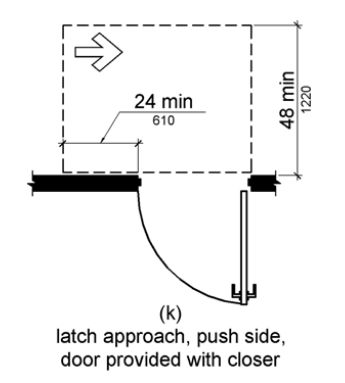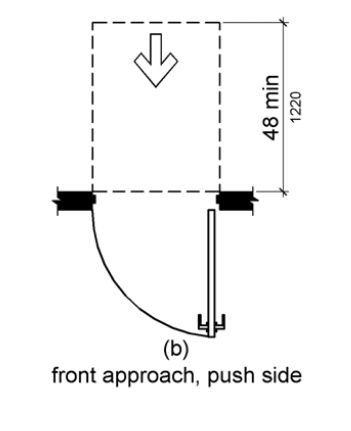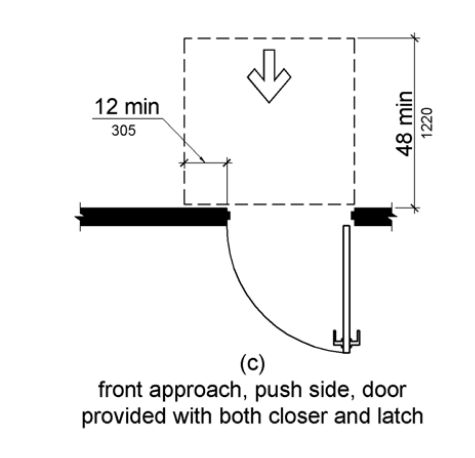A question hit my inbox a few weeks ago that I had never considered before:
Does a door with spring hinges require the same maneuvering clearance as a door with a door closer?
My initial reaction was that the door should have the proper maneuvering clearance regardless of the type of closing mechanism (keep reading – the US Access Board has a different opinion). Doors with spring hinges can be especially difficult considering that spring hinges don’t control the door like a door closer does, and are allowed by the accessibility requirements to close the door more quickly than a door closer. While a door with spring hinges might have less resistance than the 5-pound limit on opening force, some spring hinges exert a fair amount of force. I was recently contacted regarding a personal injury lawsuit that involved what the lawyer called a “door closer”…when I saw the photos, the door that allegedly caused the injury actually had spring hinges.
You may be asking yourself why this matters – here’s why. It can sometimes be difficult to provide the amount of maneuvering clearance required for a door with a closer and latch (or just a closer depending on the approach). Here are some graphics from the 2010 ADA Standards that illustrate one example of the additional clearance required when a closer is used (refer to the accessibility standards for other examples):
If a door with spring hinges is not required to have the extra maneuvering clearance, this could encourage the use of spring hinges instead of door closers to avoid providing the space needed for someone in a wheelchair to operate a door (there are animations of how wheelchair users maneuver here). In my experience, spring hinges are not as reliable as door closers; they may not close and latch a fire door or securely latch an exterior door. I would not want to encourage the use spring hinges instead of door closers and create functional issues in the process.
When I went looking for proof to support my initial answer, I found a problem. The maneuvering clearance section uses the word “closer”, and when I looked at the 2010 ADA and ICC A117.1-2017, I found that the term is not defined in either publication. In the section on closing speed, there are 2 different limits for door closers and spring hinges, which could add weight to the argument that a spring hinge is not a closer.
404.2.8 Closing Speed. Door and gate closing speed shall comply with 404.2.8.
404.2.8.1 Door Closers and Gate Closers. Door closers and gate closers shall be adjusted so that from an open position of 90 degrees, the time required to move the door to a position of 12 degrees from the latch is 5 seconds minimum.
404.2.8.2 Spring Hinges. Door and gate spring hinges shall be adjusted so that from the open position of 70 degrees, the door or gate shall move to the closed position in 1.5 seconds minimum.
In the US Access Board online Guide to the ADA Accessibility Standards, the board answers the question: “Are spring hinges and gravity hinges considered ‘closers’ in determining the size of maneuvering clearances?” According to the US Access Board, the answer is: “No. Some approaches require additional maneuvering clearances when a door or gate is equipped with a closer because of the additional force that must be counteracted in proceeding through doors. Since spring and gravity hinges do not significantly impact the opening force of doors, they are not considered ‘closers’ for purposes of specifying door maneuvering clearance.” Note that an AHJ enforcing ICC A117.1 may have a different opinion on this.
Until this is clarified in future editions of these standards, the interpretation will be left to the AHJ. It’s possible that the AHJ could allow a reduction in the maneuvering clearance based on the interpretation that a spring hinge is not a closer. Or the interpretation could be that doors with spring hinges and door closers both require the extra maneuvering clearance because both are closing devices that may make it more difficult for someone to operate the door. The less risky choice would be to use a door closer and provide the proper maneuvering clearance, rather than opting for spring hinges to dodge the requirement. Sometimes it’s necessary to look beyond the literal, and think about the intent.
What do you think?
.
You need to login or register to bookmark/favorite this content.








Lori. I agree totally with your assesment of spring hinges. Even though they can require less force to open they can still be difficult because of their inabillty to be adjusted for closing speed, or more desirable delay. That door is going to be against the wheel chair or the person all the way through the door.
My personal feeling is that they are not as access friendly as a door closer.
Love the blog!! Always thought provoking and insightful.
Dave W
Thanks David!
Do they make a spring hinge that can be adjusted to close in a minute and a half?
Not that I know of.
– Lori
I was wondering about this in relation to toilet stall partition doors which I believe are required to have the same clearances as standard doors per the ADA. I was wondering if the spring hinges on the toilet partition door meant that I would have to keep the 12″ clear next to the latch on the push side.
I had the same question. Lori?
According to my research, the spring hinges would not be considered door closers so technically the maneuvering clearance would not be required.
– Lori
ADA Board responded to this question here: https://www.access-board.gov/ada/guides/chapter-4-entrances-doors-and-gates/#are-spring-hinges-and-gravity-hinges-considered-closers-in-determining-the-size-of-maneuvering-clearances
Spring Hinges are NOT considered door closers for the purpose of maneuvering clearance.